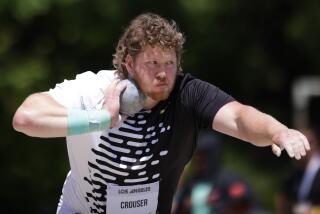Aerobatics Pilot Is Not Winging It
- Share via
Get the terminology right, says pilot Vicki Cruse of Santa Paula: Trapeze artists perform acrobatics. Pilots perform aerobatics.
Still, to onlookers, the crisp figures that the 34-year-old Cruse snips out of the sky with her nimble Edge 540 single-prop plane resemble a high-wire act.
Unlike trapeze artists, however, Cruse has no net. When she competes next year as the newest member of the United States Unlimited Aerobatic Team, it will just be Cruse, her blue-and-yellow Edge and a few thousand feet of empty air.
If something goes wrong, “You can’t fix it,” she said recently in her hangar at Santa Paula Airport. But she doesn’t mess with her own mind by thinking about that.
“You just try to be as safe as you can,” she said. “You don’t act stupid.”
Precision is her safety net. And Cruse is, if anything, precise. In a polo shirt and neat jeans, the petite Cruse conjures up an image of a Marine in mufti as she gives a tour of her immaculate hangar.
Her two planes -- the second is a commuter plane she flies to her business at Santa Monica Airport -- are parked with their noses to the sun. Tools are stored, awards hang on a wall. There’s not a drop of oil anywhere. A welcome mat printed with happy dachshunds lies, swept and spotless, on the cement floor.
“I’ve always liked dachshunds, but I’m never home” to take care of one, Cruse explained. “Even plants are a challenge.”
Instead, she’s got her planes and her knack for precision, both of which she’s been putting to use, dipping and diving above Santa Paula’s orange groves. She’s preparing for her first World Aerobatic Championship next June in Lakeland, Fla.
The competitions are held every two years, with about 20 countries participating. The U.S. team is composed of five men and five women.
A first place would be great, but with only four years of aerobatic flying under her belt, that may be a few years off, she said.
But Stephen Cunningham, just-retired president of the nonprofit United States Aerobatic Foundation, which oversees Cruse’s team, said Cruse has learned the skills necessary for aerobatic flying much faster than most pilots. She will probably start getting major trophies sooner than she thinks, he said.
“If she stays with her training routine, she can be in the top five in the world,” Cunningham said. “She’s that good.”
There are about 500 aerobatic pilots who compete in the U.S. and about 2,000 worldwide, said Geri Silveira of the Aerobatic Foundation.
The flying in aerobatic competitions is a far cry from the low-level flash and dazzle of air-show stunts, Cruse said. Instead, competitors perform so high they look from the ground like map tacks, as they take turns executing sharp maneuvers with names like Laydown Eight, Snap Rollover and Tail Slide.
Pilots perform with the help of metal grids bolted to each wing tip as sighting aids and diagrams attached to their control panels with Velcro. That’s after they have literally walked through their routines beforehand, with arms spread like wings, to memorize the patterns.
Judges award points based on the precision of each maneuver. To spectators, it has all the drama of a geometry class. But oh, Cruse said, to be in the cockpit. Her single-seater, made of lightweight but strong carbon fiber, has a 330-horsepower engine, can fly up to 250 mph and can roll at a rate of 420 degrees per second.
It can also withstand pressure up to 23 times the force of gravity, although the most Cruse experiences is about 9 Gs.
“It’s a rocket,” she said.
She fell in love with planes as a child in Springfield, Mo. Her engineer father took the family on fishing trips each summer, and while Cruse loved fishing, she loved the plane rides to get there even more.
While in college in Florida, a fellow student who owned a plane encouraged Cruse to get her pilot’s license.
After graduating with a degree in marine biology, she worked as an environmental consultant and pursued flying as a hobby.
She met her boyfriend, Dave Ronneberg, at an air show, and Cruse has owned Berkut Engineering, a kit aircraft company based at Santa Monica Airport, for 10 years now. Ronneberg designed the kit planes, which sell for $44,000.
Inspired by watching air-show aerobatics, Cruse bought her first aerobatic plane in 1995 and came to Santa Paula Airport, long a center for aerobatic training, to learn to fly it. She flew her first contest in 1997 and was soon placing high at national competitions.
One advantage, she said, is her size, or lack of it. At 5 feet 2 and 105 pounds, she can’t reach the pedals in either of her planes, so she uses pedal extensions and a booster seat to see over the dashboard. But that means she adds little weight to her already-light plane, in a sport in which lightness counts.
Aerobatic flying is not an inexpensive pursuit. Her top-of-the-line planes cost about $225,000. Expenses for competitions run $20,000 a year.
She and Ronneberg, 51, are in the process of selling their company. Since the Sept. 11 terrorist attacks, airplane sales have been down nationwide, Cruse said.
But for the moment, Cruse keeps busy in Santa Paula, practicing for the championship next June, dipping over the orange groves, turning sharply, and then roaring off into the sun.
More to Read
Sign up for The Wild
We’ll help you find the best places to hike, bike and run, as well as the perfect silent spots for meditation and yoga.
You may occasionally receive promotional content from the Los Angeles Times.






